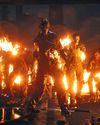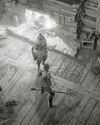The Cosa Nostra caper that subverted the Rockstar blueprint.

Back in 2001, Grand Theft Auto III gave players their first taste of the freedom 3D open-world games could offer, and it also laid out a design blueprint that developers are still iterating on nearly two decades later. It was a bullish production that seemed destined to dictate the direction of the entire industry in its wake, such was the glut of artless simulacra that followed. Over in Brno, though, they weren’t having it. Illusion Softworks had made its name with the wildly ambitious WWII action-strategy hybrid Hidden & Dangerous in 1999, and a year after GTAIII’s release it offered a dissenting voice on what gaming’s newfound expanses could be used for with Mafia: The City Of Lost Heaven. Like Liberty City, the game’s setting of Lost Heaven is a collage of familiar east coast bridges and skyscrapers, but it resolutely isn’t a playground bristling with distractions. Instead, Illusion built an enormous movie set alive with 1930s atmosphere which offered almost no diversions outside the main questline, and which hosted a straight-faced homage to mobster movies past and present.
This story is from the {{IssueName}} edition of {{MagazineName}}.
Start your 7-day Magzter GOLD free trial to access thousands of curated premium stories, and 9,000+ magazines and newspapers.
Already a subscriber ? Sign In
This story is from the {{IssueName}} edition of {{MagazineName}}.
Start your 7-day Magzter GOLD free trial to access thousands of curated premium stories, and 9,000+ magazines and newspapers.
Already a subscriber? Sign In

NO MORE ROOM IN HELL 2
You're not alone in the dark

WINDBLOWN
Life after Dead Cells

COLLECTED WORKS - JOSH SAWYER
Journeying to the Forgotten Realms, Infinity and beyond with the RPG veteran

SCREENBOUND
Going deep in a mind-bending hybrid of perspectives

Trigger Happy
Shoot first, ask questions later

Grand strategist
Paradox's Mattias Lilja addresses the publisher's recent difficulties - and the plan to right the ship

Diablo IV
A progress report on the games we just can't quit

Ghosts 'n Goblins Resurrection
In Capcom's diabolical tribute, evil goes far deeper than the demons on the screen

SERENITY FORGE
How a near-death experience lit a fire in the Colorado-based developer and publisher

THE MAKING OF...ALIEN: ISOLATION
How a strategy-led studio built a survival horror masterpiece in Ridley Scott's image